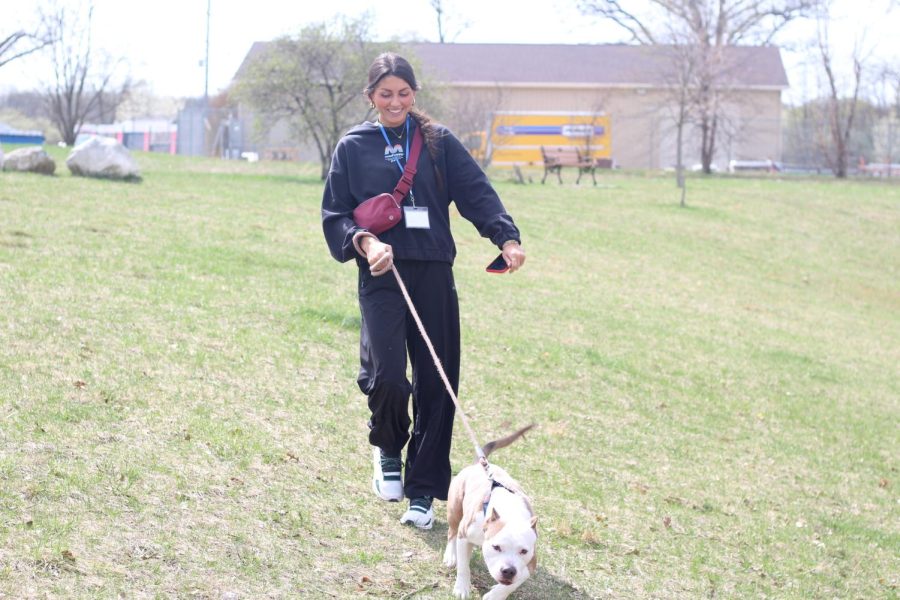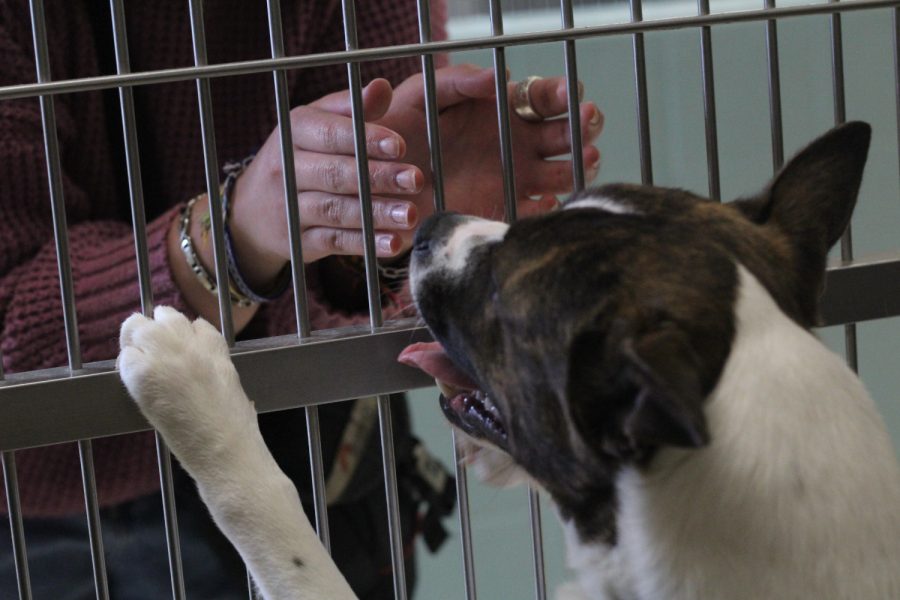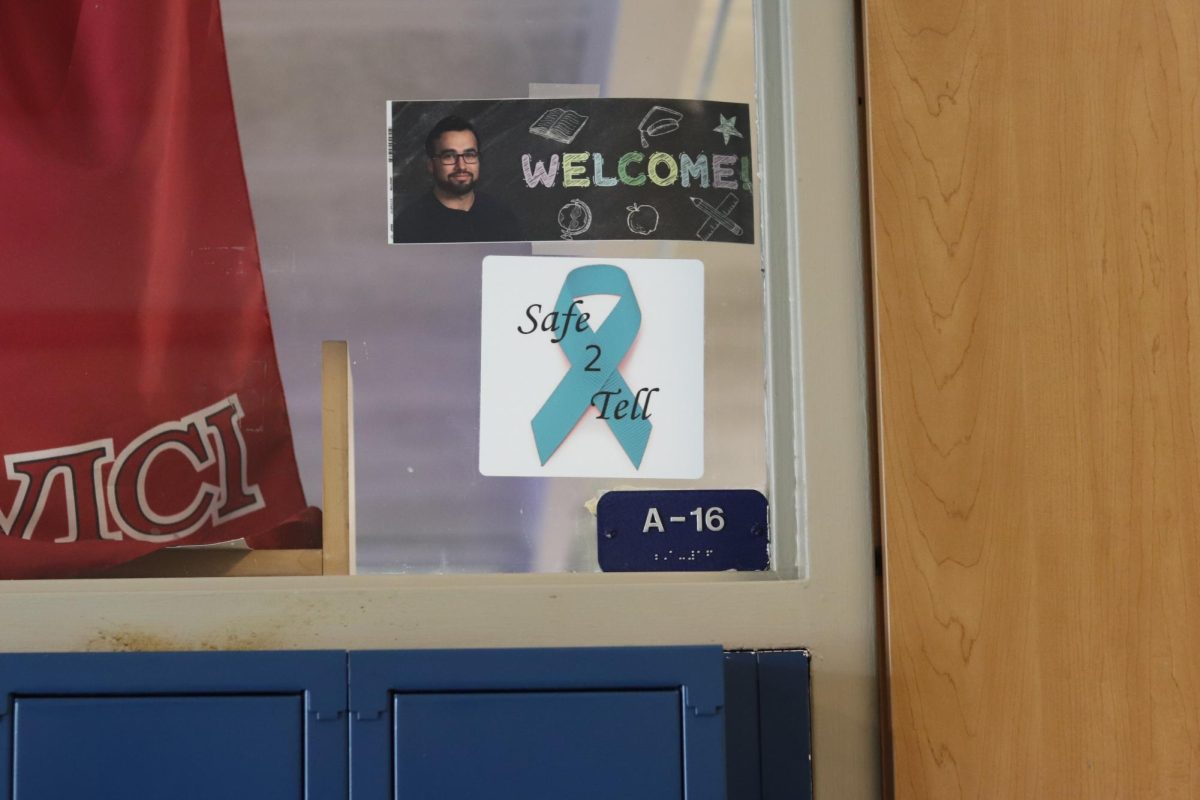The SPCA of Southwest Michigan is a no kill shelter that is committed to finding homes for dogs and cats
Credit: Isabella Figueroa
Loy Norrix alum, Olivia Boblet, spends her free time volunteering at the SPCA. Boblet is walking Otis, who she has come to love and is considering adopting.
May 17, 2023
Loy Norrix math teacher, Corey O’Bryan, adopted his dog Nova from the SPCA. He looked around at 50 other dogs before choosing Nova.
“I asked to see her, and one of the volunteers got us a room where we could interact and play with her. She was curious and calm and engaged,” continued O’Bryan, “and I found out she had surgery on her leg as a baby. I had recently had ACL/PCL surgery myself and so everything seemed to just be right.”
At the Society for the Prevention of Cruelty to Animals (SPCA), many cats and dogs are waiting to find the right person to take them home.
The SPCA was originally founded in 1866 in New York City. Since then, the program has expanded throughout the United States and eventually, worldwide.
In 2002, the SPCA opened the doors to the Southwest Michigan branch. The no-kill shelter takes in dogs and cats from several states, but most of the older pets that come to the shelter are from homes that have surrendered animals that they are no longer able to care for.
There is no limit to how long an animal can stay in the shelter. The SPCA admits a limited number of pets. The animals are not subject to euthanization unless it is a safety issue or a quality of life issue.
Additionally, spaying or neutering the animals prevents overcrowding.
The best remedy to overcrowding is adoption!
The SPCA takes steps to make sure that their animals are adoption ready. They spay or neuter the animals to prevent unwanted pregnancies and to decrease the number of stray pets.
According to the ASPCA, roughly 6.3 million pets are given up for adoption per year.
“Last year we took in just thirteen hundred [animals],” said Katie Timber, who has been executive director of the Southwest Michigan branch of the SPCA for ten years and has been working there collectively for 16 years.
Since the end of the pandemic quarantine, the shelter has seen a decrease in adoptions.
“One in 5 American households adopted during the pandemic, which was great, but then the veterinary shortage happened. The University of Florida just put this out: 2.7 million pets went unaltered [unspayed or unneutered] during that pandemic, and with limited action to veterinary care and trainers, there did start to be a large influx [of unwanted pets],” said Timber.
The rapid rise of animals in the shelter has made volunteering more crucial.
In addition to caring for abandoned animals, the shelter also works with Loaves and Fishes to provide an animal food pantry.
“We have a food pantry for pets every single day of the year. If you’re out in the world, we have a partnership with Loaves and Fishes and we give out pet food when they give out food to people food,” said Timber.
To help the non-profit animal shelter you can volunteer.
“You can sign up to volunteer, you can foster,” Timer continued,intake is going up, and we don’t want animals to just stay in the shelter, you know, we want to give them breaks. We want to get them out: we want to make sure they are well socialized.”
The SPCA allows minors to volunteer, but those under the age of 16 must be accompanied by a parent.
Loy Norrix freshman, Desmond Bradley, became a volunteer at the beginning of the 2022 school year.
“I decided to volunteer because I like animals, in general, and I wanted to help them,” said Bradley.
Becoming a volunteer is easy, the process consists of paying the one time fee. When you’re 18+ years old the fee is $25, for kids ages 8 – 17 the fee is $10. To become a volunteer sign up for orientation on the SPCA’s website.
After becoming a trained volunteer you can do things like take dogs on walks, write grant proposals and participate in in-home care. Even if you are not trained to work with the animals, you can still volunteer for other tasks like fundraising.
“There’s so many moving parts to the shelter,” Timber said, “and just not enough people, so I would say volunteering is the most effective way to help.”














James Bruce • May 21, 2023 at 2:40 am
This is awesome. I didn’t know this info!